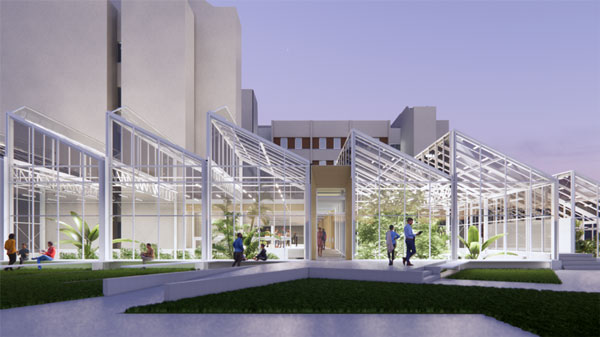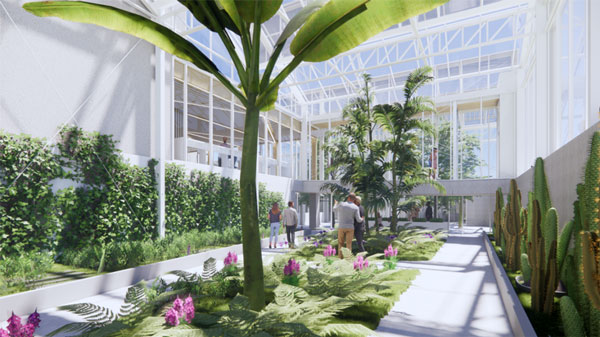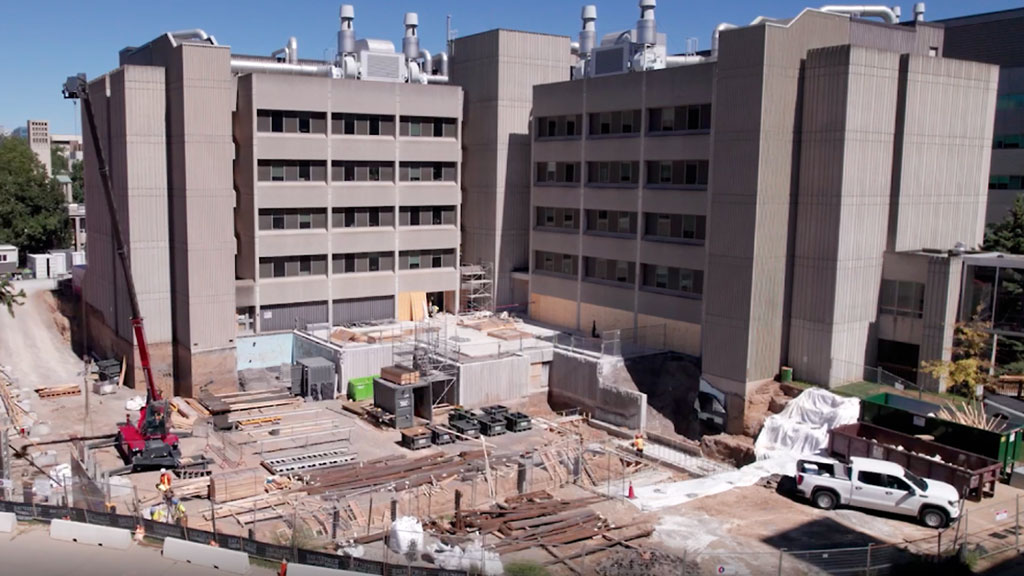Construction is underway on a massive, new, state-of-the-art greenhouse at the McMaster University campus in Hamilton, Ont. that will be heated and cooled with emissions-free geothermal energy.
The 11,400-square-foot, custom-built greenhouse, now under construction next to the Life Sciences Building, will be the first on campus to use a sustainable geothermal system to fully regulate the temperature.
“McMaster’s Net Zero Carbon Roadmap includes exploring geothermal technology on campus and this will be the first building on campus to use this technology,” explains Dave Cano, director of sustainability at the university. “This is a pilot project that will provide valuable learnings in terms of implementing geothermal heat exchange across campus as part of McMaster’s net-zero plan.”
The project has been several years in the making and is one that is a source of great excitement among faculty, staff and students in the department of biology at the faculty of science. It will eventually replace an existing facility on campus and is expected to be a game-changer as it will be much larger and better for year-round learning and research by undergraduate and graduate students.
The faculty of science collaborated with a design and construction team on the clean energy component of the greenhouse project.
“The teams met to discuss and evaluate the requirements needed for the new greenhouse,” says Cano. “The specific requirements for research required both teams to ensure the design of the new greenhouse met all standards.”
The project is expected to be completed this fall.

Geothermal systems use thermal energy naturally found deep underground, where it remains a stable five degrees Celsius, providing buildings with heat in the winter and cool air in warmer months.
The university’s carbon roadmap was developed in 2020 as a pathway to achieve net-zero carbon emissions and includes ventures such as further exploring geothermal technology, heating and cooling.
Preparation of the venture has required the installation of pipes deep underground. All in, 20 600-foot pipes have been vertically installed under the future floor area of the new greenhouse footprint.
Additional mechanical equipment will also be installed at the greenhouse location to make use of the heating and cooling coming off the pipes.
The system will use a liquid, likely glycol, to transfer heat to and from the building and into the ground.
The greenhouse itself will feature a sunken floor offering more space for plants to grow upward, with climate-controlled spaces and dedicated research and learning areas.
Sails just under the roof will help biologists customize light. Watering will be automated, further supporting ideal research conditions for the more than 200 species of plants housed in the greenhouse.
The building will provide students and faculty members with a facility to explore questions related to plant survival in the face of adverse conditions and minimize the use of fertilizers and pesticides.
According to Cano, the greenhouse build includes a few additional renovation projects that will enhance the space.
An aging current greenhouse on the campus, next to Hamilton Hall, will be retired when the new, larger structure is built. Plants will be relocated to the new venue once construction is completed.
The greenhouse attracts upwards of 3,000 visitors each year and that number is expected to rise as a result of the new venue, its accessible design and improved visitor experience due to the architecture of the building. The greenhouse will also be at the heart of the campus and near McMaster Hospital.
The greenhouse geothermal system is the second at the campus, but it is the first geothermal exchange system.
A system installed at the Gerald Hatch Centre on campus is a seasonal thermal storage system.
“We use it to store waste thermal energy from a combined heat and power system operated in the summer for direct heating or heating with extremely high COPs in the winter,” explains Cano.

The McMaster greenhouse itself will feature a sunken floor offering more space for plants to grow upward, with climate-controlled spaces and dedicated research and learning areas.
Borehole testing is presently being done at six other locations to see if it is feasible to deploy additional geothermal systems across the campus. The testing requires the contractor to drill a five-inch hole to a target depth of 850 feet. The contractor must follow all regulatory requirements to ensure the ground water or surface environment is not contaminated as a result of the work.
“After drilling, the contractor will install a geothermal U-loop which will circulate a constant flow of heated water at a constant heat injection rate for 48 hours without interruption,” says Cano. “A testing device will be equipped to automatically collect data on the water temperature and water flow.”
As part of its Net Zero Carbon Roadmap, the university is actively pursuing other ways to reduce its environmental footprint.
“We are on track to cut our total carbon emissions on campus by more than 40 per cent by the end of 2024,” notes Cano. “The Net Zero Carbon Roadmap also includes waste-water heat recovery and electrifying the fleet of service vehicles on campus. Renewable energy production using photovoltaic installations and carbon capture strategies are also potential future elements of the plan.”



Recent Comments
comments for this post are closed